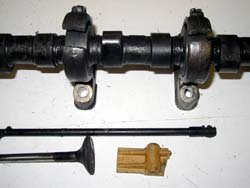When Mercedes introduced their small 3.5 liter V8 in 1970 it was hailed as a technological breakthrough in automotive engine design. That same basic design was produced for over 20 years right up into the early 1990's. The engine itself has proven to be very robust and if maintained properly will run strong for well over 300,000 miles. Time has proven though that these engines do have an "Achilles heel" and if not attended with preventative action, failure can lead to catastrophic results. The weakness I see with these engines lies in the valve train. That includes the camshafts, rocker arms, valves, and the chain mechanism that drives them. As these engines age (time not mileage) I am seeing more and more valve related problems showing up in my shop.
Problem & Solution
Common among these chassis:
In the past three months I have had to repair two different V8's that suffered catastrophic engine failure due to failure of some cheap plastic parts in the valve train. One of the cars only had 75,000 original miles on it. When I say a cheap part I mean under $10.00! In both cases the pistons came up to hit and bend the valves. Repairs in each case required very expensive engine tear down and reassembly. If it seems I am trying to scare you, yes I am. For instance, if a timing chain failure occurs at high engine speeds the engine can be completely ruined. I saw one 420SEL that had the camshaft and the cam towers blown right through the aluminum valve cover. To prevent ruined camshafts, broken chain guides, failed oiler tubes and bent valves (as pictured here) as well as ruined engines be sure to check out my V8 manual as well as the kits I am offering to help you fix it BEFORE it fails!
After reading my manual on V8 engines a Canadian friend of mine asked me to take a look at his nice 1987 420SEL. Upon removal of the left valve cover I found a broken guide rail with the loose piece rattling around under the sprocket. He was very lucky! I also found that the right side upper guide was cracked and all the oiler clips had loosened up. This car came from Alberta, Canada - a very cold place indeed. From this car and other cars I have looked at I now believe that very cold weather may play a key role in making these plastic parts brittle and prone to failure. Take note of this and act now if you live in a cold climate!
We have parts, kits and repair information available. Inspect and replace these inexpensive but critical parts before they fail. If you are not sure you can do this on your own read Kent's detailed manual first.



